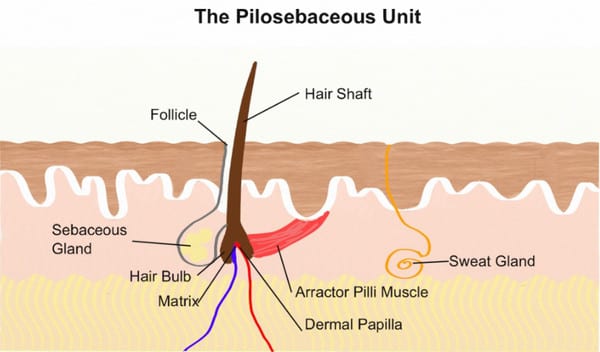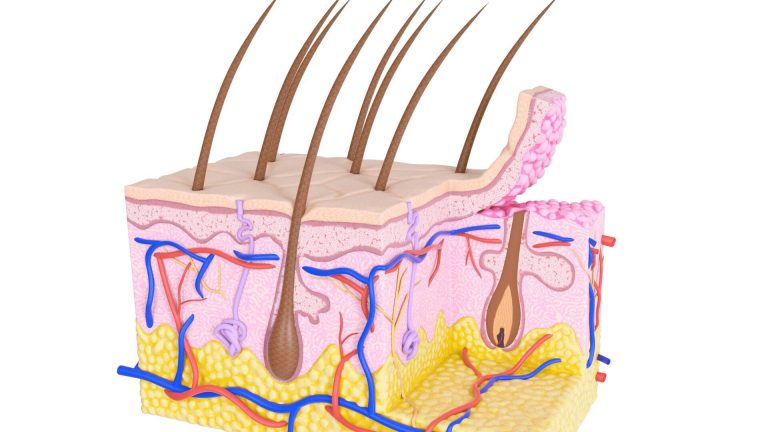
Hair Basics 101
May 5, 2021 | Hair & Hair Loss
HAIR BASICS 101
Let’s dive into hair basics. Humans are born with roughly 5 million hair follicles covering the scalp and the remainder of the body. Hair begins to develop in an embryo at the third month of gestation and continues for the next 3 months. Hair follicles are derived from the superficial epithelium via stocking-like invaginations.
The various layers of the hair follicle are derived from the self-renewing cells of the matrix portion of the hair bulb. The hair follicle is made up of concentric layers. Certain portions of the hair follicle are permanent while others including the hair shaft will be shed and replaced with each hair growth cycle. The hair shaft itself is made of a protein called keratin.

Hair Basics One
Cycles of Hair Growth
Human hair growth occurs in cycles and each follicle’s growth cycle is independent of all other follicles. This is why humans don’t shed as many animals do. There are 3 main phases of the hair growth cycle. The anagen phase is the growth phase in which the cells of the hair bulb are actively growing and dividing. This phase traditionally lasts about 3 years.
85-90% of scalp hairs are in anagen at any one time. This number decreases with age and in those with pattern hair loss. As Anagen ceases the hair goes into a transitional phase called catagen. This phase lasts 3 days to 3 weeks. The cells of the matrix stop dividing and the hair shaft becomes a club hair. The follicle then goes into the resting or telogen phase which lasts about 3 months. Anagen begins again as the matrix cells become active again and a new hair is formed which then extrudes the club hair allowing it to fall out.
The Two Types of Hair
There are two main types of hair, terminal, and vellus. Vellus hairs are very fine (0.03mm in diameter), have virtually no pigment, and are always less than 1 cm in length. Terminal hairs are longer and more coarse (0.06mm in diameter). Terminal hairs are found on the scalp, eyebrows, upper lip, chin, axillae, chest, and pubis. Hormonal fluctuations such as puberty can cause vellus hairs to turn into terminal hairs. Terminal hairs can also turn into vellus hairs. This is seen in people with pattern baldness or androgenetic alopecia.
Rate of Hair Growth
The rate of hair growth depends on how quickly the cells of the bulb matrix are able to regenerate. This rate varies between people and determines how long each person’s hair can grow and how quickly. The average hair growth of scalp hair is 0.3 mm/day.
The Shape of Hair
Whether a person’s hair is straight or curly depends on the cross-sectional shape of the hair. The cross-sectional shape of straight hair is round. Pubic hair, beard hair, and eyelash hair are oval in cross-sections. The cross-section of those with curly hair is also oval. It is this oval shape plus the curvature of the follicle just above the bulb that makes hair curly.
Hair Color
Hair color is dependent upon the density and size of pigment granules called melanosomes. Melanosomes are made by cells called melanocytes of the hair bulb. Melanosomes produce melanin which provides all tissues with color, and photoprotection. Black hair contains larger melanosomes full of melanin. Brown hair has smaller melanosomes and blonde hairs have even smaller melanosomes. Red hair has spherical melanosomes. Graying of hair is a result of a decreased number of melanocytes that produce fewer melanosomes was with aging.

Hair Basics Two
Follicular Units
The hair follicles are grouped in physiologic groupings called follicular units (FU). Each FU is made up of 1-4 terminal hair shafts, 1 vellus hair shaft, a sebaceous gland, an arrector pili muscle, and the blood vessels and nerves that nourish the unit. The overall thickness of a person’s scalp hair is determined by the number of follicular units per square centimeter. This is called follicular density. This density varies between people and even between areas of the scalp. The average density in the occipital or donor site for hair transplant is 65 to 85 hairs per square centimeter.
All of this information is why our very first step in the consultation process with each hair transplant candidate is HairMetrix hair analysis. This tool allows us to assess the follicular density in the areas of the scalp we will harvest and implant hairs. This allows for the most accurate estimate of the number of follicles needed for optimal transplant results. This analysis also tells us what percentage of hairs are terminal or vellus. If there are few vellus hairs and minimal hair loss, medical management with finasteride, supplements, PRP, and laser therapy may be considered. If there are many vellus hairs and significant hair loss at the time of consultation then a hair transplant would be recommended in addition to medical management.
Call MD Hair Labs to schedule your no-cost, no-risk consultation with our expert physicians and hair technicians!



